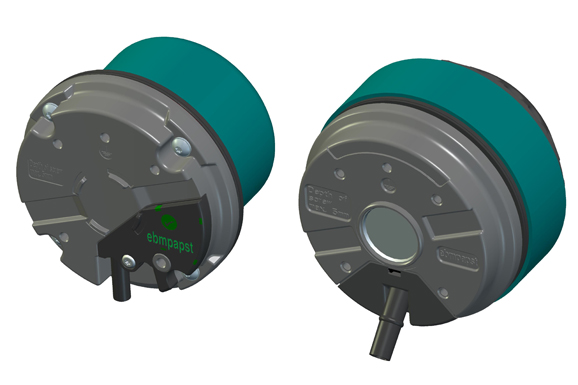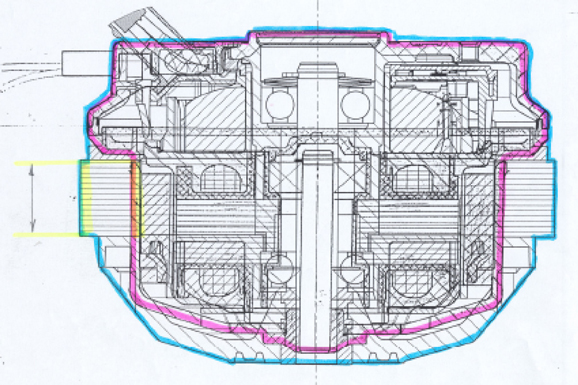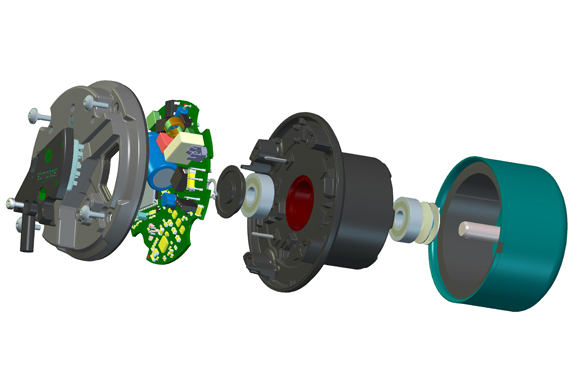The efficiency of the fans used is a central issue in ventilation and air-conditioning technology. This is encouraged not only by the statutory basis created with the Energy Conservation Directive, but also by increased environmental and cost awareness on the part of users. Against this background, it is no surprise that energy-efficient EC technology is increasingly being employed in all areas of application. To offer manufacturers of ventilation and air-conditioning units the option of continuing to use conventional AC technology or switching to energy-efficient EC technology in the future, the installation conditions for both motor technologies have to be identical. A new generation of EC motors is for the first time as compact as existing AC versions and mechanically full compatible. This means that fans can employ either AC or EC technology – without having to modify the ventilation or air-conditioning unit.
So-called “asynchronous motors” are frequently employed today to drive fans in ventilation and air-conditioning units. These AC motors are compact and simple assemblies as they are fed directly from the A/C or three-phase current supply. Neither mechanical collectors nor electronics are needed to power the rotor. They are robust and reliable. However, EC motors achieve a much higher degree of efficiency than AC motors, and this will be necessary in the near future with an eye on the requirements of the Energy Conservation Directive.
But that need not be a problem for the manufacturers of ventilation and air-conditioning units. The motors and fan specialist ebm-papst Mulfingen has developed a new generation of EC motors featuring integrated commutation and drive electronics, and which are just as compact as conventional AC motors. On both axial and centrifugal fans, the original AC motors can now be simply exchanged for a new EC design. The exceptionally high efficiency of EC motors – up to 90% – can be enjoyed without having to make design modifications to the customer’s equipment. Operating costs are cut and substantially less CO2 is generated from the very first hour of operation, reducing the impact on the environment. At the same time, the drives impress with their quiet running, which is especially beneficial for equipment used in domestic applications. The key to this is an especially low-noise commutation which is precisely adjusted to the three core electronically commutated motor.
Identical input and output dimensions
EC motors are, by way of their principle, synchronous motors actuated by permanent magnets. The magnetic rotor synchronously follows an electronically generated rotating field. This allows any random operating speeds to be realised, regardless of the power frequency used. The development represented a great technical challenge to accommodate the electronics needed by EC motors in the limited space available. Apart from the miniaturisation and optimisation of the electronics, mechanical compatibility was also a necessity. This includes, for example, the same mounting flange design as that employed on AC motors and the complete structural shape of the motor had to be modified.

The mounting area of the new EC motor (left) and that of a conventional AC motor (right) are identical.
Good heat dissipation and protection rating
The new compact EC motors are based on the proven external rotor principle in which the rotor turns around the internal stator. The stator core is coated in thermoplastic, which has several different benefits in practical application. Firstly, the high-quality plastic material provides for good electrical insulation. And secondly, the ball-bearing mounting can be integrated. Panel thicknesses and separations can be varied according to design. Tolerances in the core pack, for example, can be compensated for in this way. After this, the complete winding of the subassembly is coated with duroplastic. The single-piece rotor, which turns around the stator, has been aerodynamically optimised. Air intakes in the rotor provide for perfect heat dissipation for the stator. In conjunction with the coated stator, a high IP protection rating (IP54) is guaranteed for the motors.
The sealing of the electronics also plays an important role here. Instead of the solutions that used to be common, featuring a flange and various O-rings, the electronics case has been given an elastic sealing component. That guarantees long-term protection for the electronics. The complete motor is robust, insensitive to shock and impressed with its reliability and long service life.
Sustainable design and modular system
When designing the new EC motors, great value was attached to sustainability and to resource-conserving manufacturing. There are several details that contribute to this. The single-piece rotor with pressed-in shaft reduced the number of manufacturing steps. Multifunction components mean fewer individual parts are needed. The heat dissipation concept and a comparably compact package length also help to reduce the amount of material used. Less material input means less energy consumed during production.
The new EC motors are currently offered in size 55 with input capacity up to 170 W. Another expansion of the series is planned. The modular concept results in a modular system that permits many different variants. This way, for example, a smaller motor can be equipped with more powerful electronics. This makes sense if more output is required with the same torque. EC motors are available as standard with two speed stages. As an option, a freely adjustable speed control with a 0-10 volt control voltage is possible, e.g. for fan operation that is precisely adapted to individual requirements. In conjunction with the aerodynamically optimised HyBlade® blades or RadiCal impeller, these fans, with GreenTech EC technology, represent an energy-efficient unit in ventilation and air-conditioning technology. It is therefore possible to make an straightforward mechanical replacement of existing fans without having to modify the customer’s unit.



Leave a comment